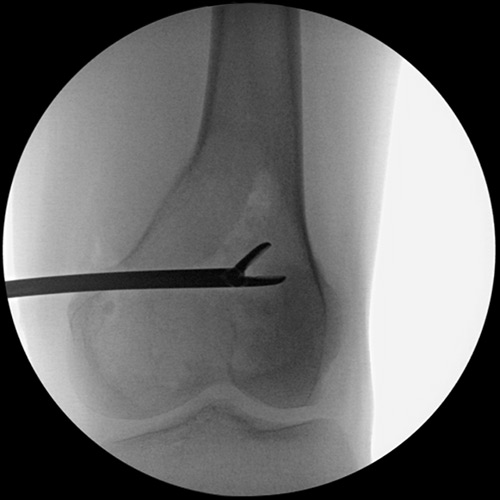Metastatic Bone Disease
What is metastatic bone disease?
Metastatic bone disease occurs when one form of cancer, like breast or prostate cancer, migrates through the body and begins to grow in bone tissue (called secondary bone cancer). This is different from osteosarcoma, a type of bone cancer that originates in bone tissue itself (primary bone cancer).
What are the symptoms of metastatic bone disease?
The initial growth usually goes unnoticed, since the bone continues to function normally. Once the cancer grows to size that is sufficient to weaken the stability of the bone, pain usually develops with weightbearing or activity (standing, running, etc.).
Who gets metastatic bone disease?
Patients with a history of cancer are at risk for metastatic bone disease. The most common types of cancer to affect the bone are breast, prostate, lung, thyroid and kidney. However, most forms of cancer can metastasize to bone. Any patient with a history of cancer should be evaluated if they begin to experience new bone or joint pain.
Bone lesions may be discovered at the time of diagnosis of the primary cancer, or they may develop years later despite thorough and appropriate treatment. Patients with a history of cancer and new abnormalities on X-ray are evaluated with a higher level of suspicion as a result. In some cases, the pain from a metastatic bone lesion may lead to a previously unknown diagnosis of cancer elsewhere in the body.
How is metastatic bone disease diagnosed?
Suspicious lesions in the bone can be identified with X-ray, CT, or MRI scans. If a patient has a history of cancer and new lesions are discovered, the patient should be evaluated by an orthopedic oncologist.
Additional imaging to evaluate the entire skeleton may be warranted. The lesion is then biopsied to make the diagnosis of metastatic bone disease. A pathologist can compare the cells from the biopsy to the primary cancer to determine if there is a match.

X-ray example of a biopsy being performed on a lesion in the distal femur (lower thighbone). In this image, a bone forcep is removing a piece of the lesion to be sent for laboratory testing.
How is metastatic bone disease treated?
Patients diagnosed with cancer often need the care of an orthopedic surgeon because the most common cancer types – breast, prostate, lung – all have a tendency to spread to bone. Most other forms of cancer can metastasize there as well. While fighting cancer is certainly difficult enough, additional pain and limited function of the arms and legs only adds to the burden. Therefore, treatment of additional sites of cancer is aimed at maximizing pain relief and return to function as efficiently as possible.
The orthopedic surgeon will be in close communication with the treating oncologist to ensure prior therapies can continue with as little interruption as possible. Choosing an orthopedic surgeon with specific knowledge and training with cancer is important because many bone metastases behave uniquely, depending on the organ the cancer originate in. The aim is to perform as few operations as possible to meet each patient’s goals and get them back to living. It is also important to evaluate for other sites of disease that may not be symptomatic yet. If treated early enough, larger procedures can often be avoided.
The surgical options available include plates and screws, rods or nails, and partial or full joint replacement. After a thorough discussion with the patient and family members, the choice of treatment is individualized. For example, a common site of metastasis is around the hip joint. This can lead to pain and difficulty ambulating or even a fracture. Some lesions will require medications and radiation only. Others are scraped from the bone and stabilized with a plate or a nail, while others may be large enough to require a joint replacement. Regardless, the objective is to minimize time in the hospital while thoroughly treating the new site of disease.
Medically reviewed by Taylor J. Reif, MD
